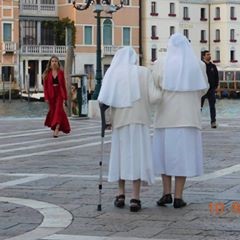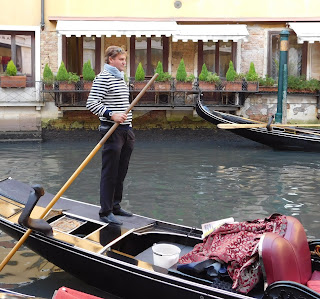Exploring Italian cities,
villages and fortified towns
Walking the lanes and streets of charming Italian villages or the larger
avenues of major Italian cities, I can experience Italian lifestyle from ground level. To appreciate the scope of the city and the
surrounding countryside you must climb.
While Italian towns
usually have a major church, some include a bell tower, other towns may have
the remains of a fortress with surviving watch towers that offer a panoramic view from above the roof tops.
| Ground views of a city are charming. |
Tourists may recognize the leaning tower in Pisa, Giotto's tower in Florence, the roof of Saint Peters' in Rome, Milan's cathedral roof top and St Mark's Campanile in Venice.
| Lines form early to visit the Campanile in St. Marks square |
To avoid the line to enter the Venice Campanile, there are other options that are open to the public and offer a 'view'.
| View of the Grand Canal you don't see from the water |
The roof top view overlooking the grand canal from the top of the former post office near the Rialto bridge, Fondaco Dei Tedeschi, (DFS) is one option. Centrally located and free (as of my visit in 2018) you reach the roof via an elevator!
| View from a vaporetto on the Grand Canal |
On-line historic data dates the building from 1228 and rebuilt in the 1500's after a fire. The four story building surrounds an inner courtyard, which now has a glass ceiling. An original fireplace and a well can be found on the first floor.
| Striking interior with open view of all 4 floors |
The DFS store brochure and where-venice.com added more details on the buildings' past. Over the centuries the building was a palace, warehouse and later a market. The ground floor water access would have given the building easy access to the merchants who traded here. Higher floors were apartments for merchant families..
Later the building was used as a post office.
The four story building surrounds an inner courtyard which now has a glass ceiling. Be sure to look UP!
The store is filled with wonderful high end fashion items, cosmetics and gift ideas. Enticing displays along the wide corridors on each floor only suggest what additional items are found in the rooms of designer fashions beyond. Black suited sales staff are close by to assist all shoppers.
All of the sales staff I met spoke English and were helpful and attentive even if you do not make a purchase. You must ask for an English version of the free brochure, available at the information desk.
Today the first floor offers a restaurant with table service as well as the amazing view up to the top floor. There is a small coffee/cake location on one side of the atrium. Tables surrounding the restaurant are filled with unique and colorful gift items or souvenirs.
The elevators at the back of the store take you up to the 4th floor.
Visits to the terrace are free but are limited to 15 minutes. The number of visitors for each time slot are controlled and guests must reserve a time online or at the computer stations on the 4th floor. Bring your confirmation with you on your phone or a printed copy.
| You wait for your assigned time to visit the roof here in the events space. |
There is a 360 view of the roof tops in the city and with the use of a telephoto lens or later photo enlarging, you can see details of many of the other buildings in the city.
If your trip does not allow enough time to book a terrace visit, there are some hotels, palaces and museums that can also offer great views as well as a peek into what life was like hundreds of years ago. Let me know what your favorites are.
Although there are many towers listed for Venice, not all of them allow visitors. Check online to be sure they currently allow visitors and what the entrance fee may be:
Scala del Bovolo, stairway to heaven, is off Campo Manin. Winding your way to the top of the building exposes more and more of the city until you have a view of rooftops and churches as well as St. Mark's Campanile. This is an easy climb, one of my favorite experiences.
| My view from the top |
The tower of San Giorgio Maggiore offers a view towards San Marco and the waterfront of Venice. You will find fewer tourists on this island and an excellent way to avoid the line at San Marco.
This is an active bell tower, you may wish to time your climb accordingly.
| The view from near St. Marks, across to the church |
The island of Torcello* has a tower in the small central square.
Reid's Italy* has a good description of this tiny island. Always check online for current times the tower may be open.
So much to see. Only a few days in Venice is never enough time.
Most data is found on Wikipedia and not guaranteed by this site, be sure to check times and prices for any site mentioned here.




